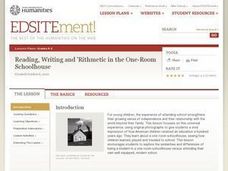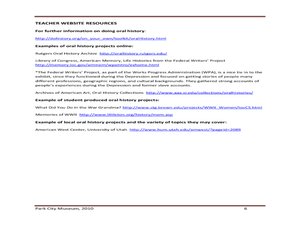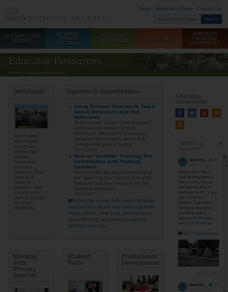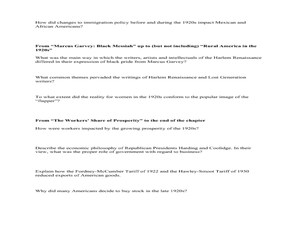Foreign Policy Research Institute
Propaganda - 9/11 and the War on Terrorism
Propaganda is an important topic that most high school social studies teachers address. Here, students compare and contrast methods of public persuasion during WWII with those used in the contemporary War on Terror. Research, discussion,...
Curated OER
Reading, Writing and 'Rithmetic in the One-Room Schoolhouse
Young scholars, through historic photographs and stories, discover the world of the one-room schoolhouse and compare it to their school experience.
Roy Rosenzweig Center for History and New Media
The Revolutionary Times as Seen Through the Eyes of Women
The role of women before and during the American Revolution changed dramatically. To gain an understanding of these changes, middle schoolers analyze primary source documents, including letters from women that supported the patriot cause...
Curated OER
Current Contexts
Young scholars examine how they are affected by world affairs. After reading an article, they examine Otto Frank's attempts to immigrate to America. Using the New York Times, they identify examples of news, advertisements and...
Curated OER
The Red Scare
Students identify and interpret issues of Nativism and Protectionism in early 20th Century America. They analyze the roots of anti-immigrant movements in the Post-World War One United States. Finally, students identify and explore the...
Curated OER
Current Connections
Many of us read our history books and take each word as truth. Show learners that history can easily be altered depending on who writes it. Your class will watch a series of videos, read a first person testimony, and discuss the...
Curated OER
Oral History: Park City Museum
Bring U.S. history to your language arts class with this lesson. Middle schoolers complete an interview for an oral history project, and discuss the importance of oral histories - and how they embellish written accounts. They write...
Curated OER
Then and Now: Tolerance as a Casualty of War
Students compare terrorist attacks on the US. In this lesson on tolerance and war, students use various resources and links to examine the concept of toleration during war. Students will focus on the attacks of Pear Harbor in 1941 and...
Curated OER
History of Miss America
Students make a time-lines of of decades using images from Miss America. In this history lesson, students looks at the country's beauty pageant and how it changes the lives of women in America. Students debate issues...
Curated OER
Memorandum of a Conference with President Eisenhower after Sputnik
Students use the National Archives to research how the United States and the Soviet Union south to maintain its supremacy after World War II.
Curated OER
U.S. Involvement in Nation-Building Before Iraq
Students analyze U.S. involvement in Iraq. In this foreign policy lesson plan, students listen to their instructor lecture on America's nation-building policies. Students respond to questions pertaining to nation-building...
Curated OER
Rural America in Transition
Students examine the changes in rural America in an economic sense. In groups, they research the problems rural areas face in the 21st century. They examine the economic policies in effect and how they help or hurt rural America.
Curated OER
The American People
For this 1920's America worksheet, learners respond to 14 short answer questions about the stocks, working conditions, the Harlem Renaissance, and wealth during the decade.
Curated OER
Society in the 1950s (5)
In this online interactive American history worksheet, students respond to 8 matching questions regarding 1950's America. Students may check their answers immediately.
Curated OER
Do We Need a Permanenet International Criminal Court?: War Crimes, Violence, International Law and Politics, Nuremberg
In this lesson plan, students explore the history, relevance and current application of international tribunals for war crimes. Students look at cases from the Nuremberg trials, Tokyo trials and the Bosnian War.
Curated OER
Plants and Animals, Partners in Pollination
Students participate in multiple hands-on activities to explore reproduction and pollination. In groups, using a cotton swab and powder, students simulate being pollinators and plants. They name the parts of the flowers and the function...
Curated OER
"ART ZOO 'Blacks in the Westward Movement', 'What Can You Do with a Portrait', and 'Of Beetles, Worms, and Leaves of Grass'"
Students study black history, examine portraits and portrait making and create their own portraits, and investigate their natural environment. This humanities lesson provides a text that can be used to teach lessons in black...
Curated OER
Remembering WWII Through Memorials
Learners create memorials for lesser known WWII heroes. In this WWII lesson, students recognize the efforts of lesser know individuals and groups that contributed to the wartime cause. Learners work in groups to create a memorial for one...
Curated OER
Navajo Code Talkers of WWII
Eighth graders assess different ways that significant individuals and events influenced economic, social and political systems in the United States after 1880. They experience a Navajo code talker's dictionary to create and decode messages.
Education World
Every Day Edit - George H.W. Bush
In this everyday editing learning exercise, students correct grammatical errors in a short paragraph about George H. W. Bush. The errors range from punctuation, spelling, grammar, and capitalization.
Council for Economic Education
Federal Budget Lesson Plan and Fiscal Ship Student Game
The federal budget has never been so fun! Using an interactive game, high schoolers choose from a variety of policy options after identifying goals and try to balance these changes in policy with a federal budget.
Curated OER
Route 66 Challenge
For this Route 66 activity worksheet, students respond to 10 multiple choice questions that require them to exhibit the knowledge they have about the American highway.
Curated OER
Boomtime
High schoolers view a short film about the rise of prosperity after World War II. They examine the role of status symbols and owning vehicles. They compare and contrast advertisements from the 1950's with those from the 1990's.
Curated OER
Meet Molly, An American Girl
Students examine saving and spending decisions in 1944 through the eyes of Molly, a nine-year-old growing up during World War II. The lesson uses Meet Molly, An American Girl, by Valerie Tripp.























